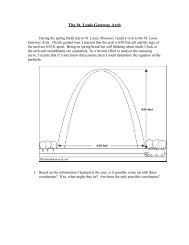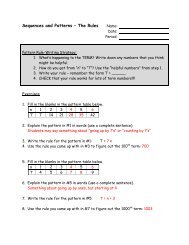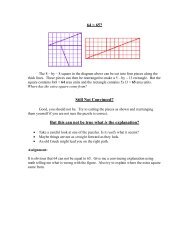Half of Half
Half of Half
Half of Half
Create successful ePaper yourself
Turn your PDF publications into a flip-book with our unique Google optimized e-Paper software.
Activity<br />
<strong>Half</strong> <strong>of</strong> <strong>Half</strong><br />
Purpose:<br />
To develop an understanding <strong>of</strong> half-life and radioactive decay.<br />
Required Equipment and Supplies:<br />
● shoe box<br />
● 200 pennies (or equivalent)<br />
● graph paper<br />
Optional<br />
Graphing calculator<br />
Discussion:<br />
Many things grow at a steady rate, such as population, money in a savings account and the accumulated<br />
thickness <strong>of</strong> a sheet <strong>of</strong> paper that is continually folded over onto itself. Many other things decrease at a<br />
steady rate, like the value <strong>of</strong> money in the bank, charge on a discharging capacitor and the amount <strong>of</strong><br />
certain materials during radioactive disintegration. A useful way to describe the rate <strong>of</strong> decrease is in<br />
turn <strong>of</strong> half life – the time it takes for the quantity to reduce to half its value. For steady decrease,<br />
called exponential decrease, the half life stays the same.<br />
Radioactive materials are characterized by their rates <strong>of</strong> decay and rates in terms <strong>of</strong> their half lives.<br />
You will explore this idea in this activity.<br />
Procedure:<br />
Step 1: Place more than 100 pennies in the shoe box and close the lid on the box. Shake the box for<br />
several seconds. Open the box and remove all the pennies head-side up. Count these and record the<br />
number in the table. Do not put the removed pennies back in the box.<br />
Total Pieces<br />
Shake<br />
Number<br />
Number <strong>of</strong><br />
pennies removed<br />
Number <strong>of</strong><br />
pennies remaining<br />
Shake<br />
Number<br />
Numbers <strong>of</strong><br />
pennies removed<br />
Number <strong>of</strong><br />
pennies remaning<br />
1
Activity<br />
Step 2: Repeat Step 1 until one or no coins remain in the shoe box. Record the number <strong>of</strong> pennies<br />
removed each time in the table.<br />
Step 3: Add the total the total number number <strong>of</strong> coins removed to find the original number <strong>of</strong> coin.<br />
Now subtract the number <strong>of</strong> <strong>of</strong> coins removed each time from the total to find the coins remaining after<br />
each shake.<br />
Step 4: Graph the Coins Remaining vs. Number <strong>of</strong> Shakes. Plot the data and draw a smooth line that<br />
best fit the points.<br />
Summing up:<br />
1. What is the interpretation <strong>of</strong> the graph you obtained?<br />
2. About what percent <strong>of</strong> the reaming coins were removed on each shake and why?<br />
3. Each shake represents a half-life for the coins. What is meant by half-life?<br />
2
Activity<br />
Going further:<br />
● Plot your data using your graphing calculator. Find the equation for the best-fit line.<br />
●<br />
Instead <strong>of</strong> using pennies, we could have used 100 dice and removed those that show a '3'. How<br />
would the half-life compare to the pennies? What if we removed the ones that came up with a<br />
'1' or a '6', how would this half-life compare to the pennies and to the half-life <strong>of</strong> the time when<br />
we just removed the '3s'?<br />
3





